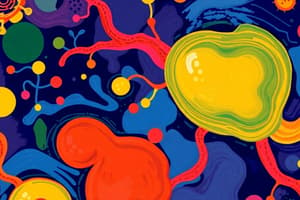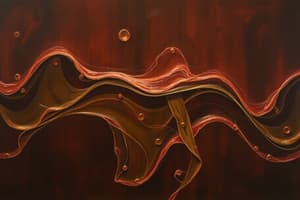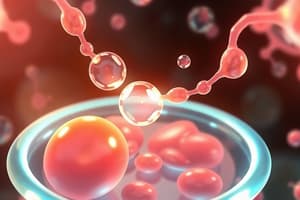Podcast
Questions and Answers
Which enzyme is NOT involved in the digestion of phospholipids?
Which enzyme is NOT involved in the digestion of phospholipids?
- Pancreatic lipase (correct)
- Phospholipase C
- Phospholipase D
- Phospholipase A1
What is the primary route for the absorption of short chain fatty acids and glycerol after they are digested?
What is the primary route for the absorption of short chain fatty acids and glycerol after they are digested?
- Systemic circulation
- Lymphatic system
- Portal circulation (correct)
- Celiac trunk
What role do chylomicrons play in lipid metabolism?
What role do chylomicrons play in lipid metabolism?
- They form depot fats in the liver.
- They transport triglycerides and cholesterol through the lymphatic system. (correct)
- They re-esterify phospholipids before absorption.
- They digest fatty acids in the intestines.
Which condition is characterized by an abnormally increased fat content in the stool?
Which condition is characterized by an abnormally increased fat content in the stool?
What happens to long chain fatty acids after absorption at the intestinal lining?
What happens to long chain fatty acids after absorption at the intestinal lining?
What is the primary role of pancreatic lipase in lipid digestion?
What is the primary role of pancreatic lipase in lipid digestion?
Which enzyme is responsible for the majority of triglyceride digestion in the small intestine?
Which enzyme is responsible for the majority of triglyceride digestion in the small intestine?
What percentage of 2-monoacylglycerols is absorbed without further conversion?
What percentage of 2-monoacylglycerols is absorbed without further conversion?
How does gastric lipase function in the digestion of lipids in infants?
How does gastric lipase function in the digestion of lipids in infants?
What end products are formed from the hydrolysis of triglycerides?
What end products are formed from the hydrolysis of triglycerides?
Flashcards are hidden until you start studying
Study Notes
Digestion of Dietary Lipids
- Adults consume approximately 60-150 grams of lipids per day, with over 90% composed of triacylglycerol (TAG).
- The remaining lipids include cholesterol, cholesteryl esters, phospholipids, and free fatty acids (FFAs).
Digestion of Triglycerides (TAG)
- Lingual Lipase: Secreted by Ebner's glands on the tongue.
- Plays a minimal role in digestion due to the short time food remains in the mouth.
- Gastric Lipase: Optimal pH is 4-6, rendering it inactive in the adult stomach due to high acidity.
- May be significant in infants' stomachs, acting on mother's milk fat containing short or medium-chain fatty acids.
- Pancreatic Lipase: Secreted into the intestine, it prefers TAG with long-chain FAs.
- Most important lipase for TAG digestion.
- Digests the primary ester bonds (positions 1 and 3), hydrolyzing them into two fatty acids and 2-monoacylglycerol.
- Requires emulsifying agents like bile salts and phospholipids for optimal action.
- Emulsification breaks down large globules into smaller ones, increasing the surface area exposed to the enzyme.
- Intestinal Lipase: Acts on 1-monoacylglycerols converting them into glycerol and FFAs.
- End products of triacylglycerol digestion include:
- 2-monoacylglycerols (72%)
- 1-monoacylglycerols (6%)
- Glycerol and free fatty acids (22%)
- End products of triacylglycerol digestion include:
Digestion of Cholesterol
- Cholesterol itself is not digested and absorbed as is.
- Cholesterol esters are digested by cholesterol esterase secreted in pancreatic juice, yielding cholesterol and free fatty acids.
Digestion of Phospholipids
- Phospholipids may be absorbed as such or digested by phospholipase enzymes (A1, A2 (B), C and D).
- These enzymes hydrolyze phospholipids into FFAs, glycerol, phosphate, and a nitrogenous base (e.g., ethanolamine, choline, serine, inositol).
Absorption of Dietary Lipids
- Short-chain fatty acids and glycerol are absorbed at the intestinal lining and pass through the portal circulation to the liver.
- Long-chain fatty acids are re-esterified into triglycerides and combined with protein to form chylomicrons, which travel in the lymph.
- Cholesterol is absorbed in its free form; it is then re-esterified in the intestinal mucosa and passes along with triglycerides in chylomicrons to the lymph vessels and systemic circulation. This results in a milky appearance of serum after fatty meals.
- Phospholipids are resynthesized in the intestinal mucosa and become part of chylomicrons.
Fate of Absorbed Lipid Fragments
- Glycerol and FFAs are taken up by various tissues for the following functions:
- Formation of depot fats.
- Oxidation for energy production.
- Synthesis of biologically active compounds.
Defects of Lipid Digestion and Absorption
- Steatorrhoea: Condition characterized by increased fat content in stool (> 5 grams/day).
- Caused by deficiency of factors essential for lipid digestion or absorption, such as pancreatic lipase, bile salts, or a healthy intestinal mucosa.
Studying That Suits You
Use AI to generate personalized quizzes and flashcards to suit your learning preferences.




